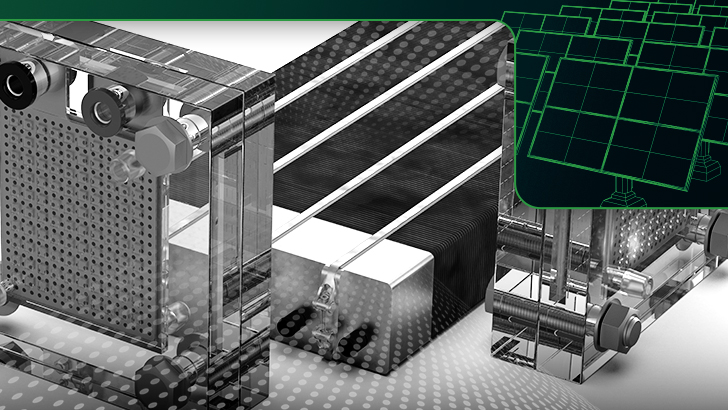

Objective
The goal of this topic is to develop conformable hydrogen storage vessels capable of storing hydrogen at 700 bar (10,000 pounds per square inch).
Description
As the Army moves towards electrifying its vehicle fleet, storing enough energy onboard vehicles to match or exceed their current performance levels remains a challenge. While batteries have made great strides in recent decades, they remain heavy and cumbersome.
A potential solution for heavy vehicles is hydrogen fuel cells that provide the benefits of electrification – such as silent mobility, silent watch, export power and high torque – while maintaining current vehicle ranges and allowing for refueling in the same amount of time as liquid fuels.
One drawback of hydrogen fuel cells is storage of the hydrogen itself. Current solutions are bulky, composite-overwrapped pressure vessels that require significant space. A way to tackle this is with a conformable tank designed to fit unusually shaped spaces and store greater amounts of energy.
This technology currently exists with a capacity of 350 bar (5,000 pounds per square inch). However, the Army seeks further advancements to meet the goal of 700 bar operating pressures.
Evaluation of these tanks under military ballistic testing also revealed potential areas of improvement for this solution. It is pivotal that the technology offers high-energy density storage capable of quick refills while reducing thermal and acoustic footprints for energy generation systems.
Phase I
This is a Direct to Phase II topic. To justify a Direct to Phase 2, the company should provide data showing a tank system made up of multiple segments (more than one) capable of 350 bar operations. At minimum, there should be data demonstrating the system can comply with proof testing and burst testing outlined in CSA/ANSI HGV 2.
Direct to Phase II
Design a 700-bar system for vehicle use that qualifies applicable to HGV 2 standards identified by both TPOC and contractor. Demonstrate the performance of the system on an applicable vehicle system. Potential Phase II Sequential and Enhancement: Scale up the design of the 700-bar system for larger storage quantities. Undergo ballistic testing of the system with military specific ballistic threats. Incorporate lessons learned from previous testing and develop 700 bar systems for specific military vehicle applications.
Phase III
There are industries that would benefit from improved hydrogen storage. This includes new use cases like PG2 tech that will rely on hydrogen storage technology for operation. Efficient hydrogen storage will become a necessity as various sectors, including transportation, metal refining and chemical manufacturing increase their hydrogen usage.
The proposed technology has potential use within the Army SBIR Program as well as other Army Research Centers and acquisition programs.
For more information, and to submit your full proposal package, visit the DSIP Portal.

References:
Objective
The goal of this topic is to develop conformable hydrogen storage vessels capable of storing hydrogen at 700 bar (10,000 pounds per square inch).
Description
As the Army moves towards electrifying its vehicle fleet, storing enough energy onboard vehicles to match or exceed their current performance levels remains a challenge. While batteries have made great strides in recent decades, they remain heavy and cumbersome.
A potential solution for heavy vehicles is hydrogen fuel cells that provide the benefits of electrification – such as silent mobility, silent watch, export power and high torque – while maintaining current vehicle ranges and allowing for refueling in the same amount of time as liquid fuels.
One drawback of hydrogen fuel cells is storage of the hydrogen itself. Current solutions are bulky, composite-overwrapped pressure vessels that require significant space. A way to tackle this is with a conformable tank designed to fit unusually shaped spaces and store greater amounts of energy.
This technology currently exists with a capacity of 350 bar (5,000 pounds per square inch). However, the Army seeks further advancements to meet the goal of 700 bar operating pressures.
Evaluation of these tanks under military ballistic testing also revealed potential areas of improvement for this solution. It is pivotal that the technology offers high-energy density storage capable of quick refills while reducing thermal and acoustic footprints for energy generation systems.
Phase I
This is a Direct to Phase II topic. To justify a Direct to Phase 2, the company should provide data showing a tank system made up of multiple segments (more than one) capable of 350 bar operations. At minimum, there should be data demonstrating the system can comply with proof testing and burst testing outlined in CSA/ANSI HGV 2.
Direct to Phase II
Design a 700-bar system for vehicle use that qualifies applicable to HGV 2 standards identified by both TPOC and contractor. Demonstrate the performance of the system on an applicable vehicle system. Potential Phase II Sequential and Enhancement: Scale up the design of the 700-bar system for larger storage quantities. Undergo ballistic testing of the system with military specific ballistic threats. Incorporate lessons learned from previous testing and develop 700 bar systems for specific military vehicle applications.
Phase III
There are industries that would benefit from improved hydrogen storage. This includes new use cases like PG2 tech that will rely on hydrogen storage technology for operation. Efficient hydrogen storage will become a necessity as various sectors, including transportation, metal refining and chemical manufacturing increase their hydrogen usage.
The proposed technology has potential use within the Army SBIR Program as well as other Army Research Centers and acquisition programs.
For more information, and to submit your full proposal package, visit the DSIP Portal.
References:
